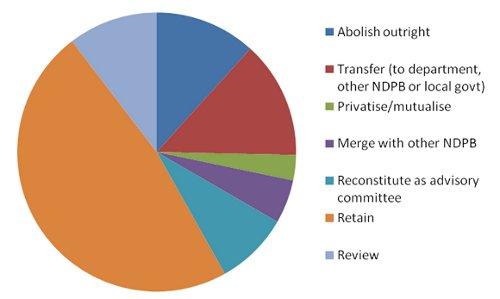The fate of quangos
The government's announcement of arm's length bodies to be reformed sees it rearranging the deckchairs of the state, rather than rolling it back.
Early on in my civil service career, I worked on the abolition of the Greater London Council (GLC). One of the Thatcher government's charges against the GLC was that it wasted ratepayers’ money on a plethora of loony left causes. But Ministers wanted to be sure that the few worthy causes 'Red Ken' might have also funded were not left stranded as the GLC rug was pulled out from under them. The then officials in charge of abolition in the department of the environment summoned officials from across government to go through the list of GLC grants, searching for ones that could be cut. One by one, departments resisted. Finally the chair read out "Sexual Relations for the Disabled - surely we don't need to fund that". But the DHSS representative piped up that not only did the GLC fund it, but so did they.
Analysing the fates of public bodies
A rather similar sense pervades the list of quangos being lined up for the bonfire (PDF, 432KB). A quick analysis of the fate of types of public body below shows that the government has found very few arm's length body functions (we have counted as one the same function performed by multiple bodies) that can be abolished outright. This may be rearranging the deckchairs of the state – but it is not rolling it back.

Dispense, retain, merge or reconstitute?
The list of bodies whose functions have been dispensed entirely with includes the Government Strategic Marketing Advisory Board, the Advisory Panel for the Local Innovation Awards Scheme and the Union Modernisation Fund Supervisory Board. The biggest category is still 'retain' (though with many also targeted for reform and undoubtedly cuts to come in the next weeks). Very few are being shifted into the private sector – either commercial or non-profit. Some bodies merge – but live on, and others see their functions transferred to other non departmental public bodies in ways that stop short of merger. Others see their functions moved into government (and the staff performing those functions will have the right to transfer too, under the public sector version of TUPE). 32 advisory bodies are reconstituted – as advisory committees. A sensible change as we recommended in Read before Burning – but no more than a belated recognition of the status quo. This announcement was about organisation, and it was interesting to see how the 'Cameron Tests' were applied in practice, as Ian Magee writes about in the Guardian. Next week we will start to see how the numbers stack up when we see the Comprehensive Spending Review announcement.
- Topic
- Public bodies
- Keywords
- Arm's-length bodies
- Administration
- Cameron-Clegg coalition government
- Publisher
- Institute for Government